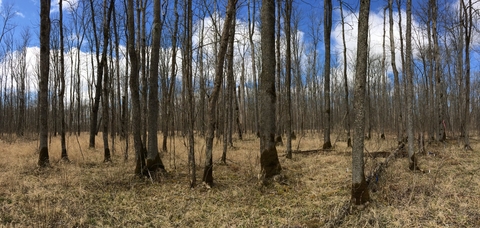Quick facts
- Hardwood products include lumber, veneer and firewood.
- Ash, cottonwood and silver maple are the most commercially desirable species.
- Bottomland hardwood species can regenerate from their light, wind-disseminated seeds. Some species also may stump sprout.
- If natural regeneration is not adequate, consider planting within two years after harvest.
- Thin and weed undesirable trees so the most desirable trees have room to grow.
- Common insect pests are the forest tent caterpillar and cankerworms.
- Major diseases include Dutch elm disease, ash yellows and cytospora canker.
Elm, ash, cottonwood, silver maple and associated hardwoods are primarily used for lumber, veneer and firewood. In some areas, cottonwood is also used for pulpwood.
You can find many wildlife species, especially birds, in a mature bottomland hardwood forest. Mature and overmature stands provide cavities essential to many wildlife species, including woodpeckers, wood ducks, barred owls and raccoons. You will also find white-tailed deer and beaver in this forest type.
Growing conditions
Species composition of bottomland hardwoods varies depending on the site, which may include American elm, green ash, black ash, eastern cottonwood, silver maple and black willow. Ash, cottonwood and silver maple are the most commercially desirable species.
Ash is common on fertile soils along rivers and streams. It is found where good moisture conditions occur in medium- to coarse-textured sands or loams to clays. Black ash can grow on wetter sites than green ash. Ash seedlings become established in partial shade on moist litter or mineral soil.
Eastern cottonwood is common on moist alluvial soil ranging from coarse sands to clays. But it grows best on fine sandy loam near streams. Cottonwood seedlings require moist, exposed mineral soil and full sunlight for establishment.
Silver maple is found on alluvial flood plains of major rivers where there are moist, fine-textured silt and clay soils that are imperfectly drained. Silver maple seedlings require moist litter or mineral soil and full sunlight for establishment.
Regenerating bottomland hardwoods
Bottomland hardwood species can regenerate from their light, wind-disseminated seeds. Some species, especially ash, also may stump sprout. To promote regeneration, clear-cut all trees greater than two inches diameter at breast height (DBH).
Tree seedlings present in the understory prior to harvest (called advance reproduction) usually are not abundant. If present, they will probably consist of elm, maple and possibly ash. A dormant season harvest encourages more stump sprouts. But plan to churn or scarify the soil surface, exposing the mineral soil so seeds can germinate.
If natural regeneration is not adequate, consider planting within two years after harvest. Because planting is expensive, confine planting to the best sites and avoid locations that frequently flood. To prepare the site:
- Shear all residual woody vegetation near ground level.
- Pile debris in windrows and burn it.
- Rake the entire surface to collect any remaining vegetation.
- Deeply disk and till the planting bed.
Cottonwood is generally established from cuttings, while ash is generally established from seedlings. Plant at a 12-by-12-foot spacing as early as possible in the spring using genetically improved stock.
Trees are more likely to survive if you use an auger instead of a planting bar. You’ll need mechanical weeding for the first two or three years.
Intermediate treatments
In very dense stands, it is recommended that you thin and weed undesirable trees so the most desirable trees have room to grow.
Do the first commercial thinning — meaning, cut and sell some trees — when codominant trees average 8 to 10 inches diameter at breast height (DBH). Codominant trees extend their crown into the canopy, receiving full light from above but little from the sides.
To sustain fast growth, you’ll need two or three more thinnings every seven to 15 years. Also, remove diseased trees and those of low vigor or poor form.
At final harvest, most stands should have 120 to 130 square feet of basal area (roughly 50 high-quality trees) per acre of commercial species. Basal area measures stand density using the sum of trees’ cross-sectional areas at 4.5 feet from the ground (known as breast height).
Pest management
Major insect pests in bottomland hardwoods are the forest tent caterpillar and cankerworms. You may need chemical or microbial insecticides to control these defoliators, as they can remove significant amounts of leaves from bottomland hardwoods.
CAUTION: Mention of a pesticide or use of a pesticide label is for educational purposes only. Always follow the pesticide label directions attached to the pesticide container you are using. Remember, the label is the law.
Major diseases include Dutch elm disease, ash yellows and cytospora canker. Harvest commercial-sized elms whenever possible to salvage their value before Dutch elm disease kills them. Retain elms during thinning only when no other desirable tree is available.
By thinning, you can reduce canker damage. It promotes tree vigor, but be very careful so you don’t damage residual trees.
Reviewed in 2019


